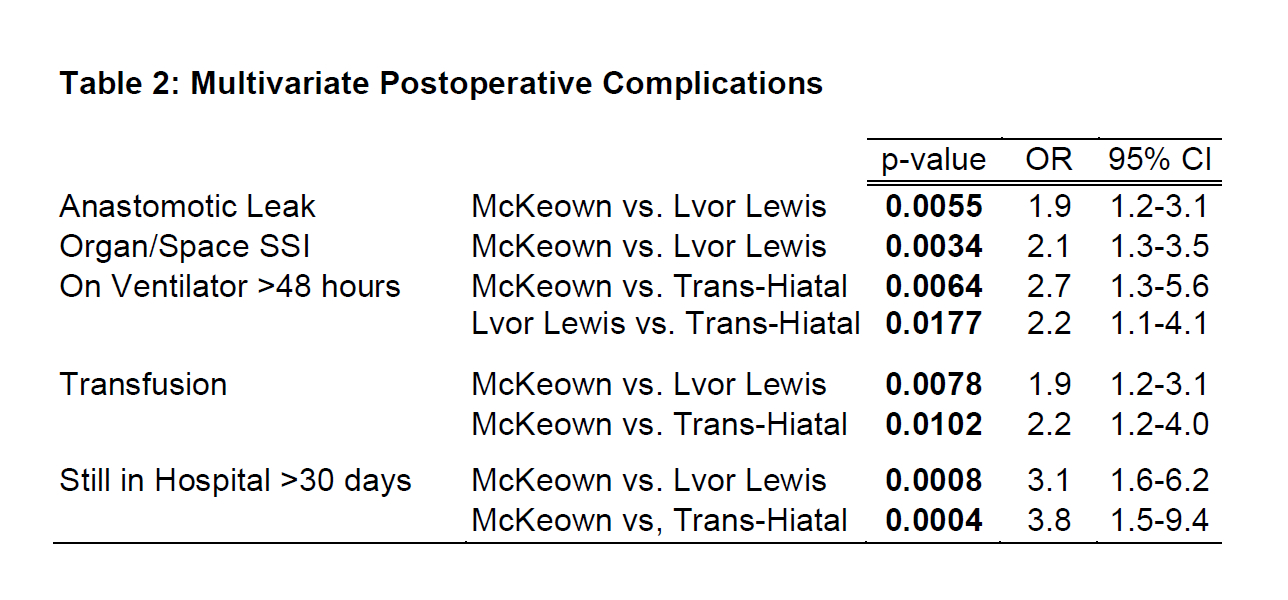30 DAY OUTCOMES AFTER ESOPHAGECTOMY BY TECHNIQUE: ANALYSIS OF MULTI-CENTER NSQIP DATABASE
Vadim Lyuksemburg*1, Jameil Abou-Hanna1, James Drake1, David Ridder1, Huaping Wang2, Eleni Stroumpi1, Steven S. Tsoraides1, Richard C. Anderson1
1Surgery, University of Illinois College of Medicine at Peoria, Peoria, IL; 2Center for Outcomes Research, University of Illinois College of Medicine at Peoria, Peoria, IL
Purpose:
Esophagectomy is the standard of care for esophageal cancer. However, this complex procedure remains with significant morbidity and mortality. There are various operative approaches for esophagectomy, each with advantages and disadvantages. Our objective was to determine how surgical approach impacts anastomotic leaks and 30 day postoperative outcomes.
Methods:
Individuals undergoing esophagectomy were identified from January 1, 2016, to December 31, 2016, using the American College of Surgeons National Surgical Quality Improvement Project (ACS-NSQIP) specific esophagectomy database. Individuals were grouped based on operative approach of Ivor Lewis, trans-hiatal, and three-incision McKeown. Primary outcomes evaluated anastomotic leak rate and 30-day postoperative outcomes. Multivariable analysis was used to examine the association between approach and 30-day postoperative outcomes, adjusting for demographics and comorbidities.
Results:
1034 patients underwent esophageal resection; of which 865 patients met criteria. Ivor Lewis approach was most common 488 (56.4%), followed by trans-hiatal 209 (24.2%) and McKeown 168 (19.4%). There was a difference between Lvor Lewis, Trans-Hiatal, and McKeown for anastomotic leaks (12.3%, 14.35%, 20.83%; p = 0.0246) and organ/space surgical site infection (SSI) (9.63%, 12.44%, 17.86%; p = 0.0167). The McKeown approach had higher rates of mortality, length of stay, and operative time. On multivariable analysis, Ivor Lewis and trans-hiatal approaches had comparable anastomotic leak rates, while McKeown was associated with higher leak rates (p = 0.0055; OR 1.9; 95% Cl 1.2-3.1), organ/space SSI (p = 0.0034; OR 2.1; 95% Cl 1.3-3.5), and admission > 30 days (p = 0.0008; OR 3.1; 95% Cl 1.6-6.2).
Conclusion:
Ivor Lewis and trans-hiatal approach had similar incidence of anastomotic leaks, postoperative outcomes, and mortality. Ivor Lewis is a reasonable approach to esophagectomy with comparable outcomes, while McKeown appears to have worse overall outcomes.

Back to 2019 Posters




